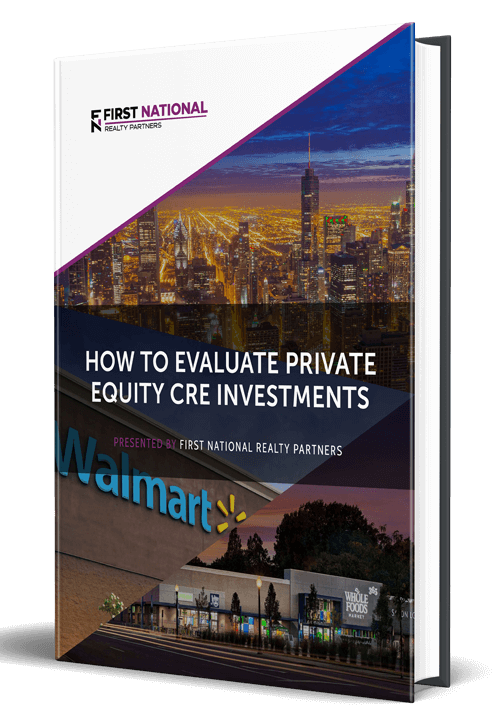Whether purchasing a stabilized property or buying one that may have a high level of vacancy, one of the metrics that many real estate investors review as part of their pre-purchase due diligence is known as “Breakeven Occupancy.”
In this article, we will review what breakeven occupancy is, how to calculate it, and why it is important in a typical commercial real estate transaction. By the end, readers should be able to calculate breakeven occupancy on their own and apply this knowledge when evaluating their own potential investments.
At First National Realty Partners, we calculate breakeven occupancy for all of our properties and use this as a way to screen for the most promising opportunities to present to our investors. To learn more about our current investment opportunities, click here.
What is Breakeven Occupancy?
When evaluating a commercial real estate investment property, breakeven occupancy is the point at which the property’s operating expenses plus loan payments are equal to the amount of potential rental income the property produces. In other words, breakeven occupancy is the occupancy level at which a property swings from an operating deficit to an operating profit.
How to Calculate Breakeven Occupancy
To measure breakeven occupancy, many investors use the “breakeven occupancy ratio,” which is calculated as:
Breakeven Occupancy Ratio = (Total Operating Expenses + Total Debt Service) / Potential Rental Income
Components of the Breakeven Occupancy Ratio Calculation
In order to understand how the breakeven occupancy ratio works, it is helpful to break it down into each of its individual components.
Total Operating Expenses
Total operating expenses represent the costs necessary to run the property on a day to day basis. Common commercial real estate operating expenses include line items like: property taxes, insurance, maintenance, utilities, and property management. They can be obtained from reviewing a property’s historical operating statements or they can be projected based on known costs for similar properties. More often than not, analysts use historical statements to estimate year 1 operating expenses and then make some assumptions about growth for future years.
Total Debt Service
Total debt service represents the total debt payments for the property. In most CRE deals, there is a single, “senior” loan from which the loan payments can be calculated based on the loan amount, interest rate, and amortization period. Combined, operating expenses and debt service represent the total costs of ownership for the property.
Potential Rental Income
Potential rental income is a bit more tricky. This is a number that represents the total amount of income that a property would produce if all units were occupied with rent paying tenants. But, in some cases, a property is not completely occupied so it is necessary to make an estimate of what the vacant units could rent for.
Example Breakeven Occupancy Ratio Calculation
So, total expenses plus debt service divided by potential rental income equals the breakeven occupancy ratio. For example, suppose a property had $400,000 in operating expenses, $250,000 in debt service, and $1,000,000 in potential rental income. The breakeven occupancy for this property would be:
Breakeven Occupancy = $400,000 + $250,000 / $1,000,000
The result is 65%. This means that any occupancy level above 65% means that the property is producing a profit. Anything below means that it is producing a loss.
How Breakeven Occupancy Is Used in Real Estate Investing
Most of the time, breakeven occupancy is calculated by real estate lenders and investors as part of sensitivity or “what if” analysis. The calculation works in two directions.
Properties with Low Levels of Occupancy
When a property with low levels of occupancy is being considered, breakeven analysis is performed so that real estate investors and lenders can answer the question “how much more space needs to be leased before the property breaks even?” For investors, the implication of this answer provides information about how much longer operating deficits need to be funded before the property makes a profit.
Determining How Much Space Can Be Vacated Before a Loss Occurs
Or, on the other side, a lender may use breakeven occupancy analysis to determine how much space can be vacated before repayment via rental income is jeopardized. For example, they may come to the conclusion that a property could lose 15% of its tenants before it will have a loss. With this information, the lender could make an assessment about how realistic this is and use it as an input into their approval decision.
What is a Good Break Even Occupancy Ratio?
There is no specific number that could be classified as a “good” break even occupancy ratio, but a general rule of thumb is lower is better. To illustrate this point, consider examples on either end of a spectrum.
At one end, suppose a 100 unit multifamily rental property had a break even point of 95%. This means that a property has to be 95% occupied for the income to be sufficient to cover all operating expenses and debt service. If this is true, there is little margin for error with this property. Assuming it was full, a loss of just 5 tenants would cause it to turn cash flow negative.
At another extreme end of the spectrum, suppose that the same property had a breakeven occupancy rate of 10%. In this case, the property could have a vacancy rate of up to 90% before operating cash flow turns negative. This is a very strong position to be in.
In reality, neither of these situations is likely. A normal breakeven occupancy range for a commercial property is usually somewhere between 60% and 80%.
Breakeven Occupancy and Private Equity
Private equity firms are one type of real estate investor and, like other real estate investors, they will calculate breakeven occupancy as part of their underwriting and due diligence process. It is important to note, however, that this is just one metric of many that they will review before making an investment decision. For example, they will also look at: net operating income (NOI), capitalization rate (cap rate), debt service coverage ratio (DSCR) and the cash on cash return. Together, all of these metrics provide a full picture of the potential return on investment that can be achieved.
Summary & Conclusion
For an income producing property, breakeven occupancy is the point at which a property goes from an operating deficit to an operating profit. Mathematically, it is calculated as total operating expenses plus debt service, divided by potential rental income.
This sort of analysis is used by lenders and investors as part of their underwriting process to establish the occupancy boundaries for a property.
As a general rule of thumb, the lower the breakeven occupancy ratio, the better. In the normal course of business, most break even ratios fall in the range of 60% – 80%.
Like all real estate investors, private equity firms calculate breakeven occupancy as part of their pre-purchase real estate analysis.
Interested In Learning More?
First National Realty Partners is one of the country’s leading private equity commercial real estate investment firms. With an intentional focus on finding world-class, multi-tenanted assets well below intrinsic value, we seek to create superior long-term, risk-adjusted returns for our investors while creating strong economic assets for the communities we invest in.
If you are an Accredited Real Estate Investor and would like to learn more about our investment opportunities, contact us at (800) 605-4966 or info@fnrpusa.com for more information.






